Umm el-Jimal
Umm el-Jimal (Arabic: ام الجمال, "Mother of Camels"), also known as Umm ej Jemāl, Umm al-Jimal or Umm idj-Djimal, is a village in Northern Jordan approximately 17 kilometers east of Mafraq. It is primarily notable for the substantial ruins of a Byzantine and early Islamic town which are clearly visible above the ground, as well as an older Roman village (locally referred to as al-Herri) located to the southwest of the Byzantine ruins.
Umm el-Jimal
أم الجمال | |
|---|---|
Village | |
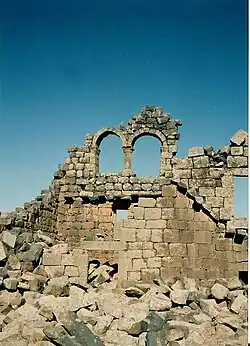 The double window of House XVIII in Umm el-Jimal | |
 Umm el-Jimal | |
| Coordinates: 32.326667°N 36.369722°E | |
| Country | |
| Governorate | Mafraq Governorate |
Overview
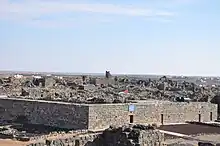
Umm el-Jimal is a large village located in northern Jordan less than 10 km from the Syrian border. It is located in the Hauran, the northern desert region of the country. Despite this aridity, Umm el-Jimal is surprisingly well suited for agriculture, and its livelihood and economy is largely derived from agricultural and pastoral sustenance. The ruins of an ancient village lie in the midst of modern Umm el-Jimal. The ruins date from the Nabataean through the Abbasid periods. The earthquake of circa AD 749 did major damage, but the community survived well into the Abbasid period. In the early twentieth century the area was repopulated by the Druze and then the Bedouin Msa'eid tribe.
History
The village of Umm el-Jimal originated in the first century AD as a rural suburb of the ancient Nabataean capital of Bostra. A number of Greek and Nabataean inscriptions found on the site date the village to this time. During the first century, the population of the site is estimated at 2,000–3,000 people. Upon the foundation of Provincia Arabia in AD 106, the Romans took over the village as Emperor Trajan incorporated the surrounding lands into the empire. In the village, the Romans erected a number of buildings including the Praetorium and the large reservoir near the castellum. After the Rebellion of Queen Zenobia in 275, Roman countermeasures included the construction of a fort (Tetrarchic castellum) that housed a military garrison. As Roman influence in the area gradually diminished, the area once again became a rural village. During the 5th and 6th centuries, Umm el-Jimal prospered as a farming and trading town in which the population jumped to an estimated 4,000–6,000 people. However, after the Muslim conquests of the 7th century, the village population diminished even though building projects and renovations continued to take place. In circa 749, an earthquake destroyed much of the area and Umm el-Jimal was abandoned like other towns and villages. The village remained uninhabited for nearly eleven hundred years until the modern community developed in the twentieth century.
Prehistory
Little is known of pre-historical times in Umm el-Jimal, aside from the few scattered remains of what appear to be settlements of nomadic hunter-gatherer tribes. In some of these places it is possible to find chert knapping stones and some prehistoric tools. In the nearby wadis the remains of kites, which are large animal traps, have been found. The prehistoric people would have used these to catch large groups of animals at once.[1]
Nabataean
The Nabataean peoples were the first to build permanent homesteads in the area in the first century AD. The settlement was mainly a farming community and a trading outpost dependent on Bostra, the nearby capital of the Nabataeans. Though the evidence for this village survives only in fragments, there are numerous Nabataean inscriptions from this period, mostly tomb stones. At least two men mentioned on these served as members of the Bostra City Council.[2]
Early Roman
As the Romans continued their conquest of the surrounding areas, the Nabataean king saw his state's demise as inevitable, so he ceded his kingdom to the Roman emperor Trajan in AD 106. The Romans named the newly acquired territory Provincia Arabia and promptly set up local governments. The Praetorium, so named by H. C. Butler in 1905, may have been built for this purpose in the third century AD.[2]
Late Roman
Everything changed after the rebellion led by Queen Zenobia of Palmyra in AD 275. The local people were no longer allowed to govern themselves, but had to submit to harsh foreign rule. Due to its location on the fringe of the Empire, Umm el-Jimal became a military outpost complete with a garrison and a new Tetrarchic-era fort. As Roman imperial power began to diminish, this earlier castellum lost its military function, and Umm el-Jimal gradually transformed from a military station to a civilian town. Paradoxically, from the point of view of the local Arab residents of the Hauran, this change may have been viewed as liberation rather than decline.[2]
Byzantine
The Roman provincial administrators were replaced by Byzantine rulers in the fifth century. One of the rulers, Dux Pelagius, built smaller military quarters. These quarters were the later castellum, which is now known as the Barracks. As the local population gradually converted to Christianity the town reemerged as a prosperous agricultural and trading community. The 150 houses still standing today were constructed in this period, the fifth and sixth centuries. In the sixth century there was an explosion of church construction, 15 of which can still be seen today. The population continued to grow, reaching an estimated 6,000 inhabitants. In the seventh century, however, power of the region was ceded to the Islamic Umayyad Empire.[2]
Umayyad
The Islamic era at Umm el-Jimal began in 640 when the Rashidun Caliphs took control of the area. Much remodeling was done throughout the site so as to repurpose buildings to suit their own needs. The Praetorium and House XVIII are examples of buildings repurposed as dwelling places, while House 53 was possibly repurposed into a mosque. Despite all of this, the population decreased and the site was slowly abandoned with the help of an earthquake in circa 749 that destroyed many buildings and set much of the architecture off balance. The site was completely deserted under the Abbasid Caliphs in the ninth century.[2]
Arab Revolt
T.E. Lawrence wrote of "ruined Um el Jemal", "There seemed evidence of bluntness of mind in these Roman frontier cities, Um el Jemal, Um el Surab, Umtaiye. Such incongruous buildings, in what was then and now a desert cockpit, accused their builders of insensitiveness; almost of a vulgar assertion of man's right (Roman right) to live unchanged in all his estate."[3][4]
Religion
Nabataean
There are a number of altars to Nabataean gods located on the site of Petra, including Dushara Aarra. Dushara, a god of Petra, is linked to Aarra, the patron god of Bostra, who become a unique regional deity. Both the Nabataean and Greek versions of his name can be seen inscribed on the die (middle section) of an altar, found in the western area of the ruins. Another god present at the site is Zeus Epikoos, a mixture of Zeus and the local deity Epikoos. In this case an altar was found in a courtyard, representative of a regional god. The altar found at Umm el-Jimal suggests personal devotion by a local resident to this deity. The third deity found at Umm el-Jimal is Solmos, who is not known elsewhere and may also be a local deity, perhaps only worshipped by the people of Umm el-Jimal and the immediate surrounding area. His name is found only once, on an altar inscription in the main ruins of Umm el-Jimal. Because this is the only known evidence of the worship of Solmos, it is reasonable to believe his worshipers were relatively few and localized. There is evidence on tombstones and small altars scattered throughout the site that suggests the worship of other deities, perhaps personal or familial gods not worshiped communally.[5]
Early Roman Pagan
Due to the tolerant nature of the early Roman occupation, little was contested during this period. The people of the region were able to continue their religious practices they had followed prior to the Roman occupation. Thus, it is likely that many of the regional gods like Zeus Epikoos and Solmos were still worshiped as the local deities.[5]
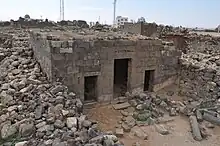
Late Roman
After the rebellion of Palmyra most of the regional religious practices stopped altogether. This was due to harsh restrictions that were implemented by the Roman government to ensure that the people would not rise up again. There is evidence however, that a small Roman shrine surviving in House 49 may have served the garrison that was stationed in the Tetrarchic castellum.[5]
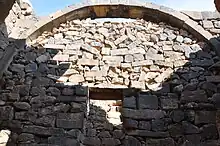
Christianity/Byzantium
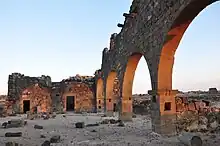
The Byzantine Empire is representative of the Christianization of the Roman Empire by Constantine in the early fourth century AD. The change in religious affiliation influenced even the far reaches of the Empire, and is therefore evident here in Umm el-Jimal. Christian symbols can be found throughout the site carved into stone and by the architectural influences. The doctrinal shift in clergy-laity (parishioner) relations is represented by the addition of altar screens in the front of the churches and narthexes to their entries. Besides Christianity's influence through the construction of multiple churches on the site, some complexes may have had monastic use. The later castellum (Barracks) was converted into a monastery by the addition of a chapel to the main building. The towers, which were also added, are inscribed with the names of the four archangels and other Christian inscriptions. The inscriptions give the impression that these successful residents relied for protection more directly on God, to whom they felt close, rather than on an emperor who seemed so far away.[5]
Islam
Umayyad Umm el-Jimal appears to have been part Christian and part Muslim with the two religious groups coexisting under the policy of the Dhimma. Scholars debate the idea that some of the churches in Umm el-Jimal were converted into mosques. In these former churches, the apse was blocked off and the focus of the structure's space was shifted south towards Mecca. Whether this is the case or not, it is more evident that two houses were converted to mosques with typically Umayyad plans and a small tower on the exterior of its west face indicating the presence of a minaret. The predominant Muslim modern community is served by several newly constructed mosques outside the antiquities.[5]
Location
The village of Umm el-Jimal is located in the semi-arid region of Jordan known as the Southern Hauran, at the western edge of the desert Badiya region. The area consists mainly of the igneous rock basalt, which was used as the primary building material. Basalt also served as a natural insulation which was extremely important in the area. In the cool winter months the basalt blocks would trap the heat from the sun and then radiate that heat throughout the structure, thus acting as a natural heating source. In the hot summer months it would serve as a cooling unit because the dense nature of the blocks trapped the cool air within the structure, despite the fact that temperatures exceed 100 °F. The volcanic nature of the soil has made it one of the most fertile areas in Jordan and Syria.
Demographics
The estimated population during the Nabataean period is unknown, because evidence of a residential community was obliterated by the later construction phases. However, because the town was likely a major trading post along the same route as Bostra, the population could have been several thousand strong. Numerous Nabataean and Greek tombstones testify to their presence. Based on the number of structures, the peak population was likely in the sixth century perhaps 3,000–7,000 people. In the Byzantine and Umayyad periods houses were occupied by both people and pastoral animals. In the Umayyad period a smaller number survived at Umm el-Jimal. While some buildings were not occupied, it was still a prosperous place and some new farmstead-type houses were constructed with characteristic Umayyad mangers. By 900, the town was abandoned. It is unknown as to why, but it was most likely due to the same reasons that the greater population of the wider region of Syria decreased; i.e., plague, drought, earthquakes, etc. Aside from these basic numbers, the general range of poor to wealthy households is largely unknown for most of the different eras of occupation. The location of the site suggests that it was rather small, but the number of buildings and churches suggest otherwise.[6]
Archaeology

Umm el-Jimal was rediscovered in the nineteenth century, during a time of Western interest in antiquities. The first systematic survey was completed by the Princeton University Expedition to Southern Syria in 1905 and 1909. The first recorded visit to the site was by William John Bankes (1786–1855) in 1818 who conducted a brief description of Umm el-Jimal. Between 1818 and 1905, many Westerners passed through the site and made a few recordings but all were brief and inconclusive. Howard Crosby Butler led the Princeton Expedition and his papers (PES II: 151) contain a more exhaustive account of those who came to Umm el-Jimal between 1818 and 1905. Butler remained at the site for two weeks mapping the site and drawing diagrams of several of the buildings. Butler's work has proved invaluable in guiding others to the site and in garnering further interest in studying the site. His survey of 1905 provided the groundwork for the field work still being conducted today.
G. Corbett came to Umm el-Jimal in 1956 to study the Julianos Church and much of his work corrected the mistakes made by Butler. Corbett also refined how Umm el-Jimal is thought of today by demonstrating that many of the buildings were constructed reusing pieces from earlier buildings. In 1972 comprehensive work was started at Umm el-Jimal by Bert de Vries of Calvin College. The ancient village was further mapped out and detailed work conducted refining the theories surrounding the nature and history of the village. The work has included conservation practices. In 1977, the walls of the Barracks were fortified with cement to prevent more collapse. The gate area of House XVIII was also fortified in 1983 with modern cement. Excavations were conducted during field work between 1972 and 1998, though the nature of the excavations was for survey and research and not for uncovering buried ruins. Since 1998 the work has centered on presentation and visual documentation of the site. Started in 2009, efforts are currently being conducted to make the site more presentable to the public.[7] A significant component of this effort is the development of a virtual museum with site tours, a compilation of the research and publications, and presentation of the heritage of the modern community and its relationship to the antiquities at www.ummeljimal.org .
In 2014, extensive damage was done to the site by tomb raiders. Sparked by rumors of gold, looters have destroyed many tombs. "The looters are looking not only for gold but for ceramics, glassware, lamps, masonry and bits of jewelry, all of which quickly find their way into the global antiquities trade."[8]
Notes
- Benjamin Hoksbergen, "The Oldest Components: The Paleolithic at Umm el-Jimal," Annual of the Department of Antiquities of Jordan 54 (Amman 2010).
- Bert de Vries et al, Umm el-Jimal: A Nabataean, Roman, Byzantine and Early Islamic Town in Northern Jordan, Vol. I, Supplement, Journal of Roman Archaeology, 1998.
- Lawrence, T.E. (1935). Seven Pillars of Wisdom. Garden City: Doubleday, Doran & Company, Inc. p. 588.
- Faulkner, Neil (2016). Lawrence of Arabia's War: The Arabs, the British and the Remaking of the Middle East in WWI. New Haven: Yale University Press. p. 428. ISBN 9780300226393.
- Bert de Vries, "Between the Cults of Syria and Arabia: Traces of Pagan Religion at Umm el-Jimal." Studies in the History and Archaeology of Jordan X. Amman: Department of Antiquities of Jordan (2009): 177-192.
- Bert de Vries, "Paradox of Power: Between Local and Imperial at Umm El-Jimal," Ch 53 in Crossing Jordan: North American Contributions to the Archaeology of Jordan. Edited by Thomas E. Levy, P. M. Michèle Daviau, Randall W. Younker and May Shaer. Equinox Publishing, Ltd, 2007.
- Bert de Vries, "The Umm el-Jimal Project, 1993 and 1994 Field Seasons," Annual of the Department of Antiquities of Jordan 39, 1995, pp. 421–435.
- William Booth and Taylor Luck (2014-10-30). "Looters raid Jordanian crypts in search of gold, jewels and artifacts". The Washington Post. Retrieved 2014-11-02.
External links
- ummeljimal.org
- Enno Littmann, David Magie Jr. and Duane Reed Stuart, Greek and Latin Inscriptions - The Umm el-Jimal Project. Princeton University Archaeological Expeditions to Syria in 1904–1905 and 1909.
- Photos of Umm el- Jimal at the American Center of Research
- Photos of Umm el-Jimal at the Manar al-Athar photo archive